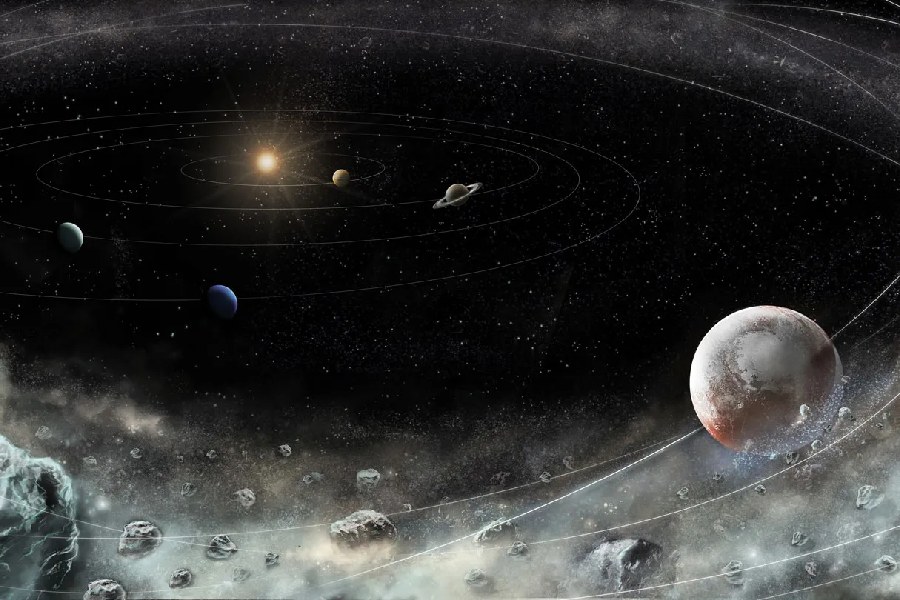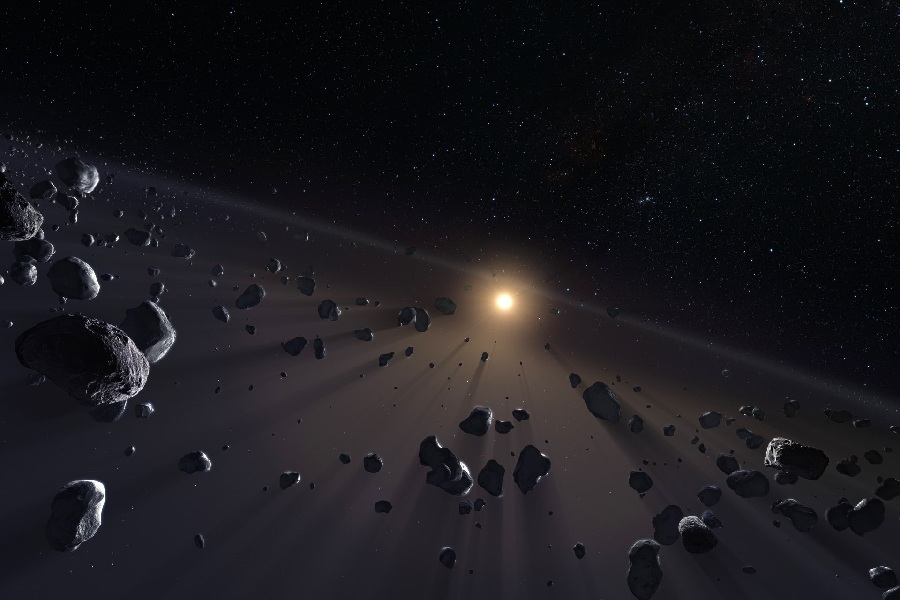In the frigid depths of our Solar System, beyond the orbit of Neptune, lies a vast and enigmatic region known as the Kuiper belt. This cosmic frontier, teeming with icy worlds and diminutive dwarf planets, has captured the imagination of astronomers for decades. But who were the intrepid explorers that first pierced the veil of this distant realm?
For years, the question of who discovered the Kuiper belt has been a subject of intrigue and controversy within the astronomical community. As the first icy objects began to emerge from the shadows in the 1990s, a battle for recognition ensued among several prominent astronomers vying for credit.
The story behind this groundbreaking discovery is one of perseverance, serendipity, and the relentless pursuit of knowledge in the face of the unknown.
This article will look back at the evidence and key events surrounding the initial discovery of the Kuiper belt.
We’ll explore the journeys and observations of the astronomers who pieced together the first clues indicating that an expansive region of icy bodies existed beyond Neptune.
The path to definitively identifying the Kuiper belt was marked by doubts and false leads. By reviewing the sequence of discoveries, we can better determine who truly deserves to be considered the discoverer of the Kuiper belt.

Who Discovered the Kuiper Belt?
Who discovered the Kuiper belt, and when was Kuiper belt discovered? The Kuiper belt was not discovered by a single individual but rather through the collaborative efforts of multiple astronomers.
The concept of a region beyond Neptune containing small, icy bodies was first proposed by astronomers Kenneth Edgeworth in 1943 and Gerard Kuiper in 1951.
However, the existence of the Kuiper belt was not confirmed until the 1990s, with the discovery of the first Kuiper belt object (KBO) named 1992 QB1 by astronomers David Jewitt and Jane Luu in 1992.
The subsequent identification of numerous other KBOs solidified the recognition of the Kuiper belt as a distinct region in our Solar System.
The Naming of the Kuiper Belt
The origin of the name
The Kuiper belt is named after Gerard Kuiper. He was a pioneering Dutch-American astronomer who made significant contributions to the study of the Solar System. Kuiper proposed the existence of this region in 1951.
He suggested it contained many small icy objects arranged in a disc-shaped region that lies beyond the orbit of Neptune. In 1992, the first Kuiper belt object was discovered, confirming Kuiper’s decades-old hypothesis. The region was then officially named after him.
Gerard Kuiper’s significance in astronomy
Gerard Kuiper (1905-1973) made significant contributions to our understanding of the Solar System. His research focused on planetary atmospheres and surface features, leading to key discoveries.
For instance, Kuiper’s spectroscopic analysis identified carbon dioxide as a major component of the Martian atmosphere. Additionally, he accurately predicted the composition of Saturn’s rings as ice particles.
Kuiper’s influence extended beyond individual discoveries. He established two prominent institutions – the Lunar and Planetary Laboratory (founded in 1960) and the Kuiper Airborne Observatory (established posthumously in 1975). These organizations continue to play vital roles in planetary science research.
Pioneering Minds – Frederick C. Leonard and Kenneth Edgeworth
Frederick C. Leonard’s proposal
Frederick C. Leonard, an American astronomer working at the University of California, Los Angeles, made a revolutionary proposal in 1930 that would forever change our understanding of the Solar System. He boldly suggested the existence of a trans-Neptunian population, a concept that was far ahead of its time.
Leonard’s idea was based on his keen observations of unusual orbital patterns. He noticed that some short-period comets were behaving strangely, with their paths hinting at a mysterious source beyond Neptune’s orbit.
Despite the fact that Leonard’s hypothesis predated Gerard Kuiper’s by over two decades, it initially failed to gain significant attention from the astronomical community.
Kenneth Edgeworth’s hypothesis
Kenneth Edgeworth, an Irish astronomer, independently proposed a similar idea in 1943. He hypothesized that the outer Solar System contained many small, icy objects.
Edgeworth theorized that these bodies were formed early on and were leftover remnants from the birth of planets. Along with Leonard, Edgeworth pioneered the concept that later became known as the Kuiper belt region.
Legacy and impact
Leonard and Edgeworth’s ideas were ahead of their time, and their hypotheses faced initial skepticism and neglect. However, their foresight eventually proved accurate when the 1992 discovery validated their theoretical proposals.
Today, the trans-Neptunian region bears both their names, as it is sometimes jointly called the Edgeworth-Kuiper belt. This commemorates the pioneering work of all three astronomers. Their vision expanded humanity’s understanding of our Solar System.

Pioneer in Planetary Science – Gerard Kuiper
Gerard Kuiper, a Dutch-American astronomer, left an indelible mark on our understanding of the Solar System. Beyond directing the Lunar and Planetary Laboratory (1960-1973), his true legacy lies in pioneering research on planetary atmospheres and the outer reaches of our Solar System.
Kuiper’s spectroscopic analysis unraveled the secrets of planetary atmospheres. His techniques, still employed today, led to discoveries about asteroids beyond Mars. But his most visionary contribution came in 1951 when he predicted the existence of a vast, icy realm beyond Neptune’s orbit – the Kuiper belt.
Decades later, this prediction became a reality, validating his theory and offering a treasure trove of information about the Solar System’s formation and the origin of comets.
Kuiper’s influence extended beyond groundbreaking discoveries. He nurtured the next generation of astronomers, and the Kuiper Airborne Observatory stands as a testament to his enduring contributions. His work laid the foundation for modern planetary science, shaping our view of the Solar System and inspiring ongoing exploration.
The Discovery Duo – David C. Jewitt and Jane Luu
David C. Jewitt and Jane Luu, two astronomers, made a groundbreaking discovery in 1992 that confirmed the existence of the Kuiper belt. David C. Jewitt, a British astronomer born in 1958 in England, obtained his Ph.D. from the California Institute of Technology.
He is currently a professor at the University of California, Los Angeles, and his research focuses on the outer Solar System, studying asteroids, comets, and Kuiper belt objects using telescopic observations and computer simulations. Jewitt has authored over 600 scientific papers.
Jane Luu, a Vietnamese-American astronomer born in 1963 in South Vietnam, received her Ph.D. from the Massachusetts Institute of Technology, where she is currently a professor.
Luu specializes in the study of small bodies in the outer Solar System, including Kuiper belt objects, comets, and asteroids. Her work combines observations with theoretical modeling, and she has published over 200 scientific papers.
The historic discovery
In 1992, Jewitt and Luu made history together. Using telescopic observations, they detected a faint, moving object. This object became known as the first Kuiper belt object (KBO) discovered beyond Pluto’s orbit. Their groundbreaking finding proved the existence of the long-hypothesized Kuiper belt region.
The 1992 KBO discovery had profound implications. It validated Gerard Kuiper’s 1951 theoretical prediction. The finding opened up a new frontier for planetary science. It sparked an intense study of the Kuiper belt and its contents.
Since their pivotal discovery, Jewitt and Luu remain active researchers. They continue studying the Kuiper belt and other outer Solar System objects. Their work enhances our knowledge of the Solar System’s origins and evolution.
Unveiling the Kuiper belt objects
Using advanced observational techniques, David Jewitt and Jane Luu detected faint objects in the outer Solar System, leading to the groundbreaking Kuiper belt discovery.
Their methodical approach involved employing a systematic observation strategy, targeting specific regions of the sky over multiple nights to detect extremely faint moving objects. This strategy required taking long-exposure images with powerful telescopes.
To accomplish this, the duo utilized the cutting-edge telescope technology of the time, specifically the powerful 2.2-meter telescope at the University of Hawaii’s Mauna Kea Observatory. The telescope’s large aperture and sensitive digital cameras were crucial in enabling the detection of extremely dim and distant objects.
Key breakthrough – The first KBO
On August 30, 1992, Jewitt and Luu’s persistence paid off. Analyzing images taken on different nights, they detected a slow-moving object. It appeared as a faint point of light against the background stars. Further observations confirmed this was a Kuiper belt object orbiting beyond Neptune.
Jewitt and Luu carefully studied the newfound object’s properties, its motion and orbit aligned with predictions for Kuiper belt objects. Spectroscopic analysis revealed an icy composition, as expected. This object, designated (15760) 1992 QB1, became the first undisputed Kuiper belt discovery.
Energized by their breakthrough, Jewitt and Luu intensified the KBO search. Over subsequent years, they identified dozens more trans-Neptunian objects. Their systematic surveys mapped out the structure of the Kuiper belt region, and each new detection provided valuable insights into this unexplored realm.
Conclusion
After revisiting the incremental discoveries and debates surrounding the Kuiper belt, we can now better appreciate the challenges in identifying such a distant region of our Solar System.
While the initial evidence was gathered by observing slight perturbations in Neptune’s orbit, more work was still needed. It took the dedicated work of multiple astronomers over several decades to definitively determine the existence and nature of the Kuiper belt.
By piecing together this historical evidence, we hope you have a clearer understanding of the winding path that led to answering who discovered the Kuiper belt. It was not the revelation of just one scientist. Instead, it took the collective efforts of an international scientific community to allow this important region of our Solar System to be mapped and defined.
This article has illuminated the complicated history of discoveries that were necessary to identify the fascinating Kuiper belt.
